Christine Carmody1
Australia's recent productivity slowdown is not an isolated occurrence. Developed economies have experienced slowing productivity growth in recent decades, particularly during the 2000s. While developed economies share a number of common features, these appear to have had varying influence on individual country performance, tempered by domestic factors. In particular, Australia's recent productivity performance appears to be driven by domestic factors rather than factors common to developed economies.
Introduction
Productivity growth is fundamental to economic growth (see Box 1), though it is not the only driver. In Australia, labour productivity growth has been historically important in supporting real income growth, while contributions from labour participation and foreign income flows have remained small by comparison (Chart 1). Indeed, the dominant contribution of labour productivity growth was only challenged in the 2000s by the contribution from a record terms of trade, which has ensured strongly rising income despite slower labour productivity growth.
In coming decades, Australia's terms of trade is projected to detract from income growth as the mining boom transitions from a period of higher prices and investment into a period of higher production. Productivity growth is once again likely to be the key source of ongoing growth in incomes and living standards. Strong productivity performance is also desirable in helping Australia to respond to developments in the international economy, the fiscal pressures of an ageing population, and climate change.
While research into the decline in Australia's productivity growth since the 1990s has focused on domestic causes, comparison with Australia's international peers can provide valuable perspective. As such, this paper examines the evolution of developed economy productivity growth, reviews possible common drivers and reflects on implications for Australia.
Chart 1: Contributions to growth in average incomes by decade
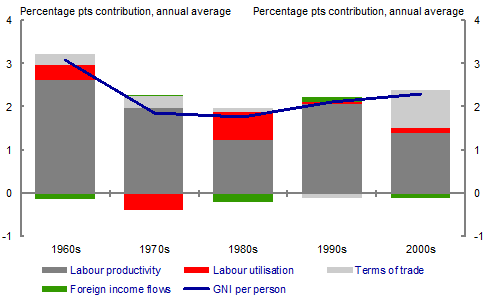
Source: Treasury calculations based on ABS cat. no. 5206.0, 6202.0 and unpublished ABS data.
Box 1. Productivity and economic growth
The Solow-Swan model (Solow 1956, Swan 1956) is the starting point for most theoretical analyses of economic growth. Its main conclusion is that the accumulation of physical capital and labour cannot drive sustained, long run growth in output per person, and that this is instead driven by the rate of technological change (productivity growth). The model assumes that the production function takes the form
Y = f(A,K,L),
where A represents technology, and K and L represent capital and labour, respectively. A is chosen as an input to the model, rather than being determined within it, and can be interpreted in terms of the stock of knowledge or innovation, disembodied education and skills, the strength of property rights, the quality of infrastructure and cultural attitudes to entrepreneurship and work. New growth theories build on the Solow-Swan concepts so that technological growth, human capital, and institutions are determined within the model (Solow 2005). Microeconomic theory has additional insights regarding a country's position on its production possibilities frontier, which represents the most efficient means of producing a range of goods and services. These concepts suggest ways by which a country can improve its economic growth.
Firstly, a country can move to a more optimal position on its domestic production possibilities frontier by changing the combination of products it produces for a given set of inputs. Secondly, a country can 'catch up' to the global production possibility frontier, by adopting more efficient processes and technologies that have been developed elsewhere. Finally, a country that is producing optimally on the global production possibilities frontier can push that frontier outward, through innovation.
Multifactor productivity (MFP) indicates the efficiency with which inputs are being used in the production process, and includes pure technological change A, along with changes in returns to scale. Labour productivity (LP) measures the level of output per unit of labour input (such as hours worked). The relationship between labour productivity growth and multifactor productivity growth is
LP growth = MFP growth + a contribution from growth in capital deepening.
In practice, measured productivity performance is influenced by all the factors that affect the level of production and the use of labour and capital. This includes competition, business cycles, trade, financial markets, technological change, weather, population growth and ageing, education, infrastructure, geography and structural change. Some of these factors are within the influence of government policy and reform to varying degrees, while others are not. The productivity performance of the private sector is ultimately determined by the actions of firms and individuals in that sector.
Long-term productivity growth in developed economies2
Over recent decades, declines have occurred in developed economy labour productivity growth, multifactor productivity growth, and — with the exception of Australia — capital deepening, although over varying timeframes.
Labour productivity
According to the Conference Board Total Economy Database, aggregate labour productivity growth in developed countries declined from a peak in the 1970s, stayed relatively unchanged during the 1980s and 1990s, and declined again in the 2000s (Chart 2).3 This encompasses the more varied behaviour of individual countries over that timeframe that can be roughly grouped into two types. In EU-15 countries, labour productivity growth has been declining steadily since the 1970s.4 By contrast, the United States (US), the United Kingdom (UK), Australia and Canada all experienced declining growth in the 1970s, a resurgence in the 1990s and a second decline in the 2000s. This is corroborated using OECD labour productivity data from 1971, for example as reported in Dupont, Guellec, and Martins (2011).
The peak in labour productivity growth in developed countries during the 1950s and 1960s has been associated with rebuilding from the World Wars and the Great Depression (Maddison 2001). In the US, rapid growth during this time was supported by an abundance of new technology that was not fully exploited during the Great Depression and World War II. Other countries took advantage of the new opening of trade and mobility of technology following the war to catch up to the US productivity level. Some slowing in the 1970s has been considered to be inevitable in developed economies after this period (Maddison 2001).
Chart 2: Labour productivity growth
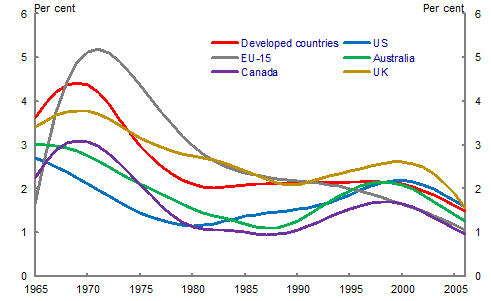
Source: The Conference Board Total Economy Database, 2013. Treasury calculations. Trends are calculated using a Hodrick-Prescott filter for the period 1950-2012, however a shorter timeframe is shown in the chart to avoid uncertainty with endpoints.5
The reversal of this slowing for the US, UK, Canada and Australia in the 1990s has been attributed mainly to the effects of reform during the 1980s and 1990s and also the impacts of information and communications technology (ICT), as will be reviewed in subsequent sections of this paper. In particular, dive rgent approaches to reform generated widespread commentary of an emerging 'productivity gap' between Europe and the US in the 1990s. In continental Europe, productivity growth continued to decline as product market reforms were slow and hesitant during most of the 1990s, when the diffusion of ICT was particularly intense. During the late 1980s and 1990s, several European countries also introduced labour market reforms and interventions to reduce unemployment and raise the participation rate, dampening labour productivity growth (Timmer and Inklaar 2011).
The decline in labour productivity growth common to developed countries during the 2000s requires more detailed explanation. Insights can be gained by looking at the contributions from multifactor productivity growth and capital deepening.
Multifactor productivity
Data from the Conference Board Total Economy Database show that aggregate MFP growth for developed countries has decreased steadily from the 1970s to the present day (Chart 3). The World Productivity Database also shows a general decline in MFP growth in many developed countries over the period from 1961 to 1998; exceptions include Ireland and Norway.
More detailed data from 1990 available from The Conference Board Total Economy Database enable decomposition into individual countries and regions. This shows declines in country MFP growth between the mid-1990s and mid-2000s (Chart 4). Alternative data sources (OECD and EU KLEMS data) also indicate falls in MFP growth during this period.
Distinct industry developments contributed to developed country MFP slowdowns in the 2000s, although the underlying reasons for this may be disparate. While detailed industry by industry analysis would be required to further explore the reasons for this, the fact that different groups of industries have been affected in different countries points to the role of domestic factors.
Chart 3: Developed country MFP growth
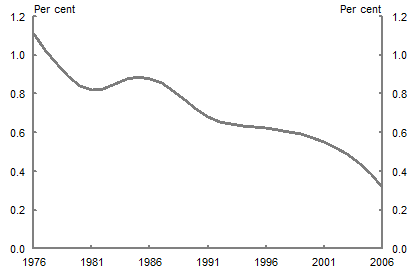
Source: Content reproduced with permission from the Conference Board, Inc. © 2013 The Conference Board, Inc. http://www.conference-board.org/data/economydatabase/. Trend is calculated using a Hodrick-Prescott filter for period 1971-2013; however, a shorter timeframe is shown to avoid uncertainty with endpoints.
Chart 4: Multifactor productivity growth
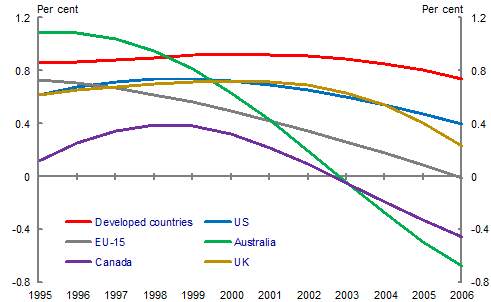
Source: The Conference Board Total Economy Database, 2013. Trends are calculated using a Hodrick-Prescott filter for period 1990-2012, however a shorter timeframe is shown in the chart to avoid uncertainty with endpoints.
In Australia, all market sectors except for accommodation and food services experienced lower MFP growth between 2000 and 2007 than in the 1990s, with slowdowns particularly marked in mining and utilities (ABS 2013). This broad-based slowdown has been attributed to lost momentum for reform; delays in output from investment associated with the commodities boom; drought; lumpy investments in utilities; and adjustment pressures as businesses respond to the high Australian dollar and higher prices (Parham 2012, Eslake 2011, Dolman 2009).
In the US, the post-2004 MFP slowdown has manifested in manufacturing, construction and distributions services and a declining role of ICT following the dot-com crash of 2000s, while MFP in financial and business services grew strongly (van Ark 2010, Jorgenson, Ho, and Stiroh 2008). It should be noted however that the productivity performance of the financial services industry is partly attributable to the activities and regulatory environment which subsequently led to the global financial crisis.
The European MFP slowdown since the mid-1990s has some similarities with the more recent slowdown in the US, in that it has included declines in manufacturing and construction, as well as motor vehicle trade. In contrast to the US, MFP growth in financial and business services fell along with trade following rapid growth in the early 2000s, while MFP growth in ICT production, telecommunication services and utilities was positive (Timmer, Inklaar, O'Mahoney and van Ark 2011).
Capital deepening
Capital deepening has been a significant component of developed country labour productivity growth in recent decades (see for example Chen, Gupta, Therrien, Levanon and van Ark 2010). Indeed, increasing contributions from capital deepening have been a key feature of Australian labour productivity growth since the early 1990s, in contrast to gradual declines in the contribution from capital deepening in developed countries in aggregate, the US, and European countries (Chart 5).
Despite this, the slowdown of labour productivity growth in OECD countries over the period 1985-2008 has been found to be driven more by a deceleration in MFP growth than by reduced contributions from capital deepening (Dupont, Guellec and Martins 2011). This trend includes Australia, where a decline in MFP has actually outweighed an increase in capital deepening.
Chart 5: Capital deepening
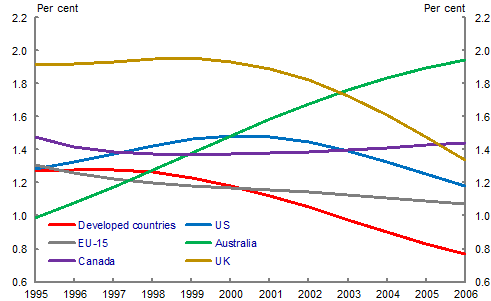
Source: The Conference Board Total Economy Database, 2013 and Treasury calculations. Trends are calculated using a Hodrick-Prescott filter for period 1990-2012; however, a shorter timeframe is shown in the chart to avoid uncertainty with endpoints.
Factors relevant to declining productivity growth in developed economies
Possible explanations for simultaneous developed economy productivity growth declines include a falling pace of innovation, the fading impact of breakthroughs in ICT technology, a similarly fading impact of past economic reforms, and sectoral shifts to lower productivity sectors. These will be discussed in turn.
Innovation
As a small open economy, Australia is not expected to play a major role in pushing the production possibilities frontier outward, except in specific areas of comparative advantage such as mining. Rather, our ongoing potential for productivity growth will be supported by adoption of a variety of innovations developed overseas.
The question is whether the global pace of innovation, and thereby the pace at which the global production possibility frontier is pushed outward, is linked to the observed slowdown in developed economy productivity growth.
The impact of global innovation is not likely to be immediate, given that it can take some time for new innovations to be converted to production methods, which then must be taken up by many businesses or individuals to affect national productivity performance in a substantial way. This means that a given innovation, leading to new technology, will have variable impacts on production, over variable timescales. Some innovations have been very important for global or national productivity growth, while others have had a small to negligible impact.
Slowing innovation is a thesis of Robert Gordon (Gordon 2012), who has argued that periods of slow and rapid growth at the global frontier have resulted from three industrial revolutions, manifesting in a growth peak in the middle of the 20th century and a decline ever since.6 One of Gordon's conclusions is that there are no remaining opportunities to improve the pace at which the global frontier moves in the way that past industrial revolutions have. Similarly, Tyler Cowen has argued that the American economy has reached a historical technological plateau and the factors which dr ove economic growth for most of America's history are mostly spent (Cowen 2011).
These arguments align with the observed long-term decline in aggregate developed economy MFP growth shown in Chart 3. However, their accuracy is difficult to foresee given that it is not possible to know what new technologies will be developed and what their impact will be on production.
Chart 6: Annualised growth in patent applications
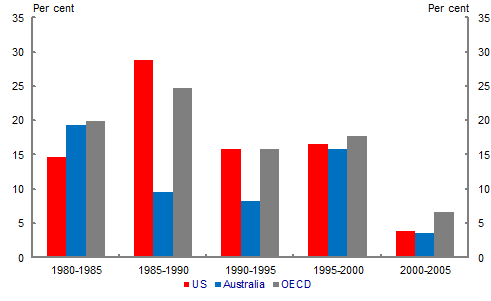
Source: OECD Science, Technology and R&D Statistics 2013. Applications under the Patent Cooperation Treaty by inventor country.
Chart 7: Annualised growth in trade-mark applications
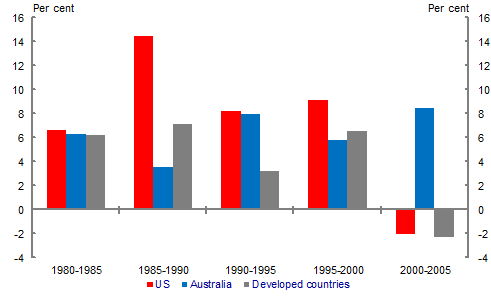
Source: World Intellectual Property Organisation 2012.
Chart 8: Annualised growth in business R&D expenditure
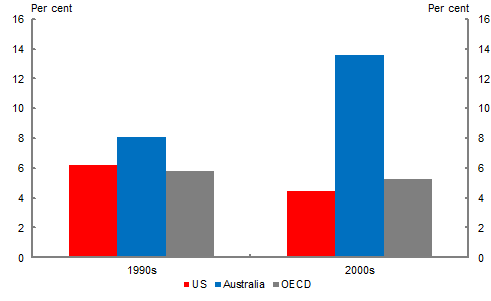
Source: OECD Science, Technology and R&D Statistics 2013.
It is interesting to compare the result of Chart 3 with a rough assessment of the rate of global innovation. This can be done using a range of indicators, which test innovation activity but not the quality of that activity in terms of its impact on productivity growth. A commonly-used indicator is the number of patents applied for or granted, since patents have previously been associated with accelerations in inventions.7 Expenditure on R&D by government or business is also correlated with inventions, although loosely because an amount of expenditure does not necessarily reflect the amount of innovation that is produced. Trade-mark activity measures the introduction of new goods and services into the market, or changes in marketing strategies for existing products, and thus reflects a more immediate impact on productivity. However, business innovation encompasses much more than these measures. Australian firms undertaking innovation are more likely to invest in purchasing new equipment, training and marketing than investment in R&D or acquiring intellectual property (AG 2011). Innovation surveys in the EU, US and Japan have also found that firms consider patents to be less important than many other means of appropriating their investments in innovation (Arundel 2001).
Acknowledging these issues, the pace of innovation activity in developed countries indeed looks to have lessened in the 2000s, though a slowdown is not obvious for the 1980s or 1990s. Patent applications, trademark applications, and business funded R&D growth in developed economies and the OECD have also declined in the 2000s, although the latter two indicators remained strong for Australia (Charts 6, 7 and 8 and Dupont, Guellec and Martins 2011).
Australia's relatively strong performance in the latter two indicators reflects the effects of the commodities boom and strong income growth in the 2000s. Primary and resource-based industries account for a much larger share of business expenditure on R&D than the OECD median and play a significant role in the recent increases (OECD 2012).
The recent declines in innovation indicators do not match the long-term MFP growth decline of Chart 3. This is not necessarily inconsistent, given that MFP reflects the final impact on production efficiency, and thus is linked to both the quality of innovation as well as its quantity.
Information and Communication Technology
During the 1990s, the results of innovation in information and communication technology (ICT) became widely available, bringing expectations of a widespread positive contribution to productivity growth. Some countries were better able to take advantage of new technological breakthroughs than others, leading to variable uptake of ICT and increased dispersion of productivity performance in developed economies (OECD 2007). Despite this, most of country output and labour productivity growth between 1995 and 2008 has been attributed to non-ICT capital services.
The contribution of ICT to output and productivity growth can occur through:
- ICT production, with an acceleration of MFP and labour productivity growth in the ICT-producing sectors and an increase of their weight in the economy; and
- ICT use, comprising capital deepening where rapid investment in ICT equipment boosts production and labour productivity and also boosts MFP where production rises more than overall inputs. Sectors that are the most intensive users of ICT are ICT production and finance and business services, while goods production and personal services are the least ICT intensive (Jorgenson and Timmer 2011).
ICT production made large contributions to productivity growth in the United States and the UK in the 1990s, whereas the contributions were moderate for continental European countries and very small for Australia and Canada (Inklaar, Timmer and van Ark 2007). This result is consistent with only a few OECD countries being specialised in those ICT sub-sectors characterised by rapid technological progress, such as the production of semi-conductors and computers.
ICT use strengthened labour productivity and MFP growth in the US and Australia during the 1990s (Pilat, Lee, and van Ark 2002, Gretton, Gali and Parham 2004). ICT played a critical role in the post-1995 productivity growth resurgence in the US while other forms of capital deepening and labour-quality growth made insignificant contributions in this period (Jorgenson, Ho and Stiroh 2008). The US market services sector in particular benefited from the increase in ICT use, particularly wholesale and retail trade and financial services (see for example van Ark, O'Mahoney and Timmer 2008).
For most other OECD countries, there is little evidence that ICT-using industries experienced a consequent improvement in labour or total factor productivity growth. ICT investment and the productive use of ICT in Europe generated less productivity growth during the 1990s because of the slower pace of reform (Pilat, Lee and van Ark 2002).
ICT investment continues to increase in all sectors and regions (Jorgenson 2011). In the OECD, the share of ICT investment rose from 10 per cent of total investment in 1985 to 20 per cent in 2002. It was substantially higher in relatively lightly regulated economies such as Australia, Finland, Sweden, the UK and the US, compared to more heavily regulated continental European economies (OECD 2007).
Despite this, more recent data suggest that ICT capital is not providing an ongoing contribution to developed country productivity growth, consistent with the concept of diminishing returns (see Chart 9, Gordon 2010, and Jorgenson, Ho and Stiroh 2008). In most OECD countries, the contribution of ICT capital to GDP growth rose between 1985-1994 and 1995-2001, but fell subsequently (Dupont, Guellec and Martins 2011). In the United States, the contribution of ICT to productivity growth fell significantly after 2000, although it still accounted for one third of productivity growth between 2000 and 2006 (Jorgenson, Ho and Stiroh 2008). Unlike other developed countries, the contribution of ICT capital services to Australian GDP growth increased during the 2000s, however the experience of other countries raises questions about whether this will continue.
Chart 9: Contribution of ICT capital services to GDP growth
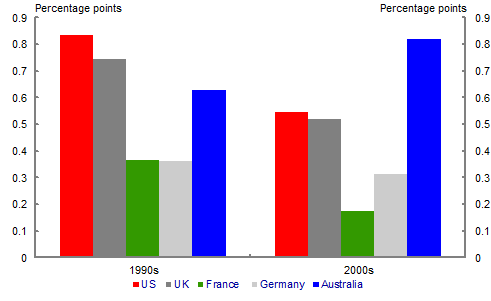
Source: The Confer ence Board Total Economy Database 2013.
Economic reform
Economic reform is considered to be a key contributor to the mid-1990s productivity growth resurgence of countries such as the US and Australia relative to their continental European counterparts. Labour productivity growth has increased in lightly-regulated economies but either grew more slowly or decelerated in highly regulated countries (OECD 2007b).8
Reforms can affect productivity through several channels, as outlined in Box 2. Those that impact on the functioning of markets are expected to deliver a short term boost to productivity growth as the economy moves to a new productivity level, followed by a longer-term and smaller contribution to growth to the extent that innovation is supported by new policy settings. Given this, a waning of the effects of previous reforms has been offered as a reason for declining Australian productivity growth in the 2000s (Dolman 2009).
Box 2. Reform and the timing of impacts on productivity
The impact of reform on productivity can occur on a range of timescales.
Theory suggests that regulation and reforms which liberalise or improve the functioning of markets can positively affect productivity through three different channels (Nicodème and Sauner-Leroy 2004):
- A reallocation of scarce resources (allocative efficiency).
- An improvement in the use of production factors by firms (productive efficiency).
- An incentive for firms to innovate to move to the production possibilities frontier (dynamic efficiency).
Gains through allocative and productive efficiency generally represent one-off changes to the level of productivity and changes occur in the short run. However, an increase in competition may also stimulate firms to develop product and process innovations and hence to speed up the move to the production possibilities frontier. The corresponding impact on productivity is likely to take much longer as successful innovations eventually raise the level and growth rate of total factor productivity in the long run.
Efficiency-enhancing public sector reforms aimed at reducing slack in public sectors or state-owned enterprises, trade liberalisation and reforms affecting inefficient industries are likely to materialise relatively quickly.
By contrast, education and innovation reforms, the effects of lighter product market regulation on technology adoption, and financial market liberalisation impacts on more efficient capital allocation, might take time to materialise. Price or wage stickiness is likely to delay the full impact of a reform, all else equal (Bouis, Causa, Demmou, Duval and Zdzienicka 2012).
Institutional settings can also affect the dynamic impact of reforms. For example, settings that favour labour reallocation such as well-designed active labour market policies or housing policies can speed the adjustment to long run equilibrium. On the other hand, where job protection increases employment persistence and impedes labour reallocation, it may also slow down the impact of some other reforms.
Reforms across the OECD over the past two decades have resulted in policy convergence in areas including macroeconomic stabilisation and more market-oriented product market regulation, however GDP per capita and productivity performance have diverged in that time (OECD 2007). As outlined in Box 1, reform is only one of many factors that can influence measured productivity and economic growth performance. Nevertheless, it has been suggested that the relationship between the timing of policy reforms and the timing of technological change is also important. Because relatively liberal countries benefit from improvements in the world production possibilities frontier more quickly than countries with more restrictive policy regimes, the effect of product market regulation on the speed of catch-up is amplified when the frontier moves outwards rapidly, such as may have occurred with ICT in the 1990s (Conway and Nicoletti 2007).
Opportunities for reform have not been exhausted, and there are a number of areas where significant policy differences remain between countries. The OECD considers that annual productivity growth could have been at least ¾ of a percentage point higher between 1995 and 2003 in half of OECD countries if regulations had been at the level of the most lightly regulated in the OECD for each sector. Gains in labour productivity growth of at least half a percentage point per annum over a decade would also be possible if countries further reformed their product markets (OECD 2007).9
Because the timing of reform and impacts on the economy can vary substantially, it can be difficult to pin down specific effects, and in some cases it may be too early to expect any impacts. Dolman (2009) noted that important factors underpinning Australian productivity growth over the long term and specifically in the 1990s — investment in ICTs, education and skills, R&D activity and infrastructure spending — had not diminished in the 2000s. Nevertheless, the waning effects of previous reforms cannot be discounted as a contributor to the slowdown in productivity growth in developed economies.
Sectoral shifts
The movement of resources between sectors can contribute to aggregate productivity growth. If resources move from industries with high productivity levels to those with low productivity levels, this would be reflected in a negative contribution to aggregate productivity growth, even if productivity within individual industries is unchanged.
Detailed analysis of whether developed economies have shifted resources to industries with high or low measured productivity levels is a task beyond the scope of this paper.10 Nevertheless, recent evidence of productivity performance in services relative to manufacturing does not conform to a simple prediction that a move of resources from manufacturing to services could be detrimental to developed country productivity growth. Rather, the shift to services has resulted in mixed impacts. The productivity performance of individual services sub-sectors is also not uniform, suggesting that it is inappropriate to consider them in aggregate (Inklaar, Timmer and van Ark 2007).
Conclusion
Australia's productivity slowdown in the 2000s is not isolated among developed countries. As for our international peers, it has been driven by declining MFP growth. However, the size of Australia's MFP decline suggests the importance of domestic drivers alongside factors common to developed economies. The role of domestic factors is also indicated in the way that MFP growth declines in different developed economies are playing out in different groups of sectors.
Potential common drivers of developed economy productivity growth slowdowns include falling rates of innovation, the fading impacts of ICT and past economic reforms, and sectoral shifts to lower productivity sectors. In addition to long-term declines in developed economy MFP growth, there is some suggestion that the pace of global innovation has slowed in the 2000s alongside a fading of the positive contribution of ICT to productivity growth. The waning effect of past reform is relevant for countries that have not maintained reform momentum though the late 1990s and into the 2000s, although it is difficult to determine to what degree given that the size and timing of reform impacts are not clear-cut. Finally, a sectoral shift to services does not necessarily mean a reduction in productivity growth performance and prospects.
There is also a question as to whether lower multifactor productivity growth rates should be expected in advanced economies. Declines in advanced economy multifactor productivity growth over preceding decades remain unexplained by the evidence collected in t his paper; however, there may be some merit in the arguments concerning the declining quality of innovation made by Robert Gordon and Tyler Cowen. As such, the fate of our overseas peers will be of ongoing interest as the domestic factors currently influencing Australia's productivity performance run their course.
References
AG 2011, 'Australia Innovation System Report', Australian Government.
Arundel, A 2001, 'Patents — the Viagra of innovation policy?', Internal report to Expert Group on Innovation Policy in a Knowledge-Based Economy project, European Commission.
Bassanini, A Scarpetta, S and Visco, I 2010, 'Knowledge, Technology and Economic Growth: Recent Evidence from OECD Countries', OECD Economics Department Working Papers 259.
Bloom, N and van Reenen, J 2007, 'Measuring and Explaining Management Practices Across Firms and Countries', The Quarterly Journal of Economics, vol. 122, pp 1351-1408.
Bouis, R Causa, O Demmou, L Duval, R and Zdzienicka, A 2012, 'The short-term effects of structural reforms: an empirical analysis', OECD Economics Department Working Papers 949.
Cowen, T 2011, The Great Stagnation: How America Ate All the Low-Hanging Fruit of Modern History, Got Sick, and Will (Eventually) Feel Better, Dutton.
Chen, V Gupta, A Therrien, A Levanon, G and van Ark, B 2010, 'Recent Productivity Developments in the World Economy: An Overview from The Conference Board, Total Economy Database', International Productivity Monitor, vol 19, pp 3-19.
Conway, P and Nicoletti, G 2007, 'Product Market Regulation and Productivity Convergence: OECD evidence and implications for Canada', International Productivity Monitor, vol 15, pp 3-24.
Dolman, B 2009, 'What Happened to Australia's Productivity Surge?', Australian Economic Review, vol 42, pp 243-263.
Dupont, J Guellec, D and Martins, J 2011, 'OECD Productivity Growth in the 2000s: A Descriptive Analysis of the Impact of Sectoral Effects and Innovation', OECD Journal of Economic Studies, pp 1-23.
Eslake, S 2011, 'Productivity: The Lost Decade', Paper presented to Reserve Bank of Australia Conference on The Australian Economy in the 2000s, Sydney, 15 August.
Gordon, R 2010, 'Revisiting U. S. Productivity Growth Over The Past Century With A View Of The Future', NBER Working Paper 15834.
Gordon R 2012, 'Is US Economic Growth Over? Faltering Innovation Confronts the Six Headwinds', NBER Working Paper 18315.
Gretton, P Gali, J and Parham, D 2004, 'The effects of ICTs and complementary innovations on Australian productivity growth', in The Economic Impact of ICT — Measurement, Evidence and Implications, OECD, Paris.
Inklaar, R Timmer, M and van Ark, B 2007, 'Mind the Gap! International Comparisons of Productivity in Services and Goods Production', German Economic Review, vol 8, pp 281-307.
Jorgenson, D Ho, M and Stiroh, K 2008, 'A Retrospective Look at the US Productivity Resurgence', Journal of Economic Perspectives, vol 22, pp 3-24.
Jorgenson, D and Timmer, M 2011, 'Structural Change in Advanced Nations: A New Set of Stylised Facts', Scandinavian Journal of Economics, vol 113, pp 1-29.
Maddison, A 2001, 'The World Economy. A Millennial Perspective', Development Centre of the Organisation for Economic Co-operation and Development, Paris, pp 22, 131.
Nicodème, G and Sauner-Leroy, JB 2004, 'Product market reforms and productivity: a review of the theoretical and empirical literature on the transmission channels', European Economy Economic Papers number 218, Directorate General Economic and Monetary Affairs, European Commission.
OECD 2007, Going for Growth, Organisation for Economic Co-operation and Development.
OECD 2007b, 'Innovation and Growth: Rationale for an Innovation Strategy', Organisation for Economic Co-operation and Development.
OECD 2012, 'Science, Technology and Industry Outlook 2012: Australia', Organisation for Economic Co-operation and Development.
OECD 2013, Going for Growth, Organisation for Economic Co-operation and Development.
Parham, D 2012, 'Australia's Productivity Growth Slump: Signs of Crisis, Adjustment or Both?', Visiting Researcher Paper, Productivity Commission, Canberra.
Pilat, D Lee, F and van Ark, B 2002, 'Production and Use of ICT: A Sectoral Perspective on Productivity Growth in the OECD Area', OECD Economic Studies, vol 35, pp 47-78.
Solow, R 1956, 'A Contribution to the Theory of Economic Growth', Quarterly Journal of Economics, vol 70, pp 65-94.
Solow, R 2005, 'Reflections on growth theory', Handbook of Economic Growth, vol 1, pp 3-10.
Swan, T 1956, 'Economic Growth and Capital Accumulation', Economic Record, vol 32, pp 334-61.
Timmer, M Inklaar, R O'Mahony, M and van Ark, B 2011, 'Productivity and Economic Growth in Europe: A Comparative Industry Perspective', International Productivity Monitor, vol 21, pp 3-23.
Timmer, M O'Mahoney, M and van Ark, B 2007, 'EU KLEMS Growth and Productivity Accounts: An Overview', November 2007 release, University of Groningen.
van Ark, B O'Mahony, M and Timmer, M 2008, 'The Productivity Gap Between Europe and the United States: Trends and Causes', Journal of Economic Perspectives, vol 22, pp 25-44.
van Ark, B 2010, 'Productivity, Sources of Growth and Potential Output in the Euro Area and the United States', Intereconomics 2010, vol 1, pp 17-20.
van Reenen, J Bloom, N Draka, M Kretschmer, T Sadun, R 2010, 'The Economic Impact of ICT', London School of Economics.
1 The author is from Macroeconomic Group, the Australian Treasury. This article has benefited from comments and suggestions provided by Ben Dolman, Simon Duggan, Harry Greenwell, David Gruen, Mitch Pirie, and Duncan Spender. The views in this article are those of the author and not necessarily those of the Australian Treasury.
2 The focus of subsequent analysis is on empirical data. No assumptions are made about the pace of country convergence to the global production possibilities frontier, contrary to methods commonly used in forecasting international economic growth rates. The period following the global financial crisis has been omitted given its influence on the relationship between output and labour markets, and thus national productivity statistics.
3 Developed countries refers to the Conference Board definition of mature economies, which includes Austria, Belgium, Cyprus, Denmark, Finland, France, Germany, Greece, Iceland, Ireland, Italy, Luxembourg, Malta, Netherlands, Norway, Portugal, Spain, Sweden, Switzerland, United Kingdom, Canada, United States, Australia, New Zealand, Japan, Singapore, South Korea, Taiwan, Israel, and Hong Kong.
4 EU-15 countries include members of the European Union prior to May 2004: Austria, Belgium, Denmark, Finland, France, Germany, Greece, Ireland, Italy, Luxembourg, Netherlands, Portugal, Spain, Sweden and the United Kingdom.
5 When making international comparisons of growth performance, differences in business cycle conditions across countries are often addressed by comparing average growth rates over sufficiently long time periods to minimise cyclical influences. However, the lack of country business cycle synchronisation, even over five-year periods, has made this approach difficult. Instead, long-term analyses can rely on trend series estimated using the Hodrick-Prescott filter (Bassanini, Scarpetta and Visco 2010).
6 Gordon defines the three revolutions as steam an d railroads between 1750 and 1830; electricity, the internal combustion engine, running water, indoor toilets, communications, entertainment, chemicals and petroleum from 1870 to 1900; and computers, the internet and mobile phones from 1960 to the present.
7 The highest growth of patent numbers ever occurred in the 1880s, when electrical technology was invented and modern chemistry discovered. Patents are applied to and granted by national or regional offices, to applicants coming from any country and seeking protection in the relevant market for their invention.
8 New Zealand remains a puzzle. It undertook a wide range of reforms similar to those in Australia, but did not experience a revival in productivity growth.
9 Following the global financial crisis, the OECD notes that reforms have been continuing, particularly in the areas of wage bargaining and job protection as countries seek to boost job creation and facilitate the reallocation of resources towards growing sectors. Pension reforms were already occurring at the onset of the crisis and have accelerated under the pressures to ensure debt sustainability. The need to put public budgets on a sustainable path and regain competitiveness has also been a major driver of productivity-enhancing reforms in a number of OECD countries. Governments have increased the efficiency of taxation, encouraged competition in product markets and improved cost-efficiency in the public sector (OECD 2013).
10 This would involve consideration of: methods for determining productivity levels, which industries have grown (such as various service industries) and which have shrunk (such as manufacturing), and which industries are measured to have high and low productivity levels (with results differing between individual countries).